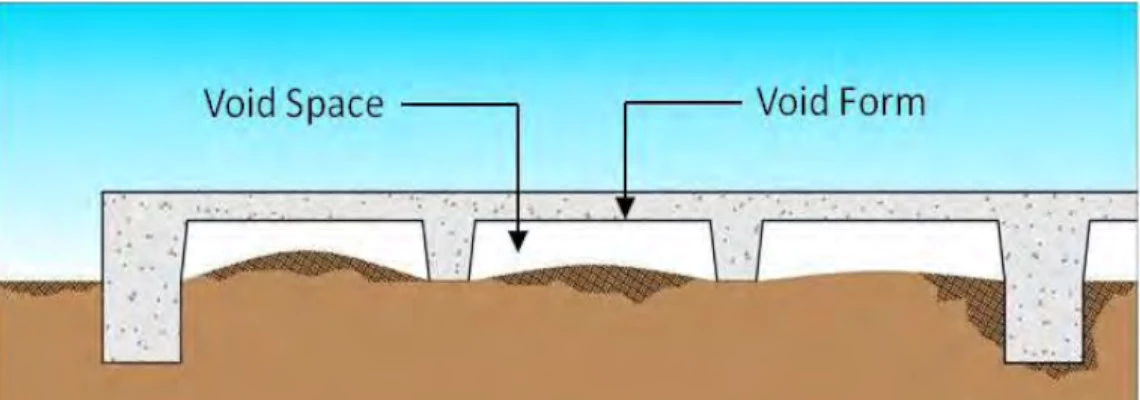
WHAT PRODUCTS CAN BE USED FOR VOID FORMING IN CONCRETE CONSTRUCTION?
The current construction materials market is flooded with various innovations that can be challenging to keep up with, especially when undertaking a construction project, perhaps for the first time in your life. An example of such a situation is when building an extension or your own house, and the initial challenge lies in finding the right material for void filling in concrete construction.
This article is precisely dedicated to this topic. By reading it, you will learn about the types of void formers available, where they are applied, and which ones are most popular in the UK.
WHAT IS VOID FORMER?
Void former is a material used to create empty spaces or voids within a concrete structure.
These voids serve various purposes, such as reducing the overall weight of the structure or improving insulation. In concrete construction, voids (gaps between layers) are created to provide access to services and lighten the structure.
Void formers are commonly used in construction projects where it's necessary to incorporate hollow sections within concrete elements, such as floors, walls, or slabs.
For instance voided slabs are reinforced concrete slabs in which the volume is reduced by forming voids inside the slab. The voids are provided by placing void formers inside the slab.
In this case void materials are placed in the middle of slab in between the top and bottom of the reinforcing mesh. Voided slab reduces self-weight by 40% in comparison with the solid slab of the same capacity.
Void formers are also designed to provide a buffer zone between expansive soils and a concrete foundation in order that heave can occur without imposing detrimental uplift pressures to the foundation.
Once again Void Formers can:
- Reduce amount of concrete
- Reduce soil excavation
- Absorb expanding soil volume
- Create more stable slab
TYPES OF VOID FORMS
There are 3 types of void formers that can be used in concrete construction:
1. Removable, inflatable formers, pneumatically inflated;
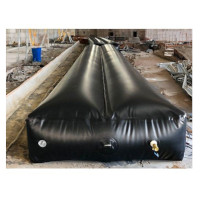 A removable void former suggests that there is enough space for it to be taken out, with inflatable types generally needing less space compared to rigid ones. Consequently, there are specific formers suitable for tasks where a continuous open-ended void or duct is essential, or where the placement needs to occur in stages.
A removable void former suggests that there is enough space for it to be taken out, with inflatable types generally needing less space compared to rigid ones. Consequently, there are specific formers suitable for tasks where a continuous open-ended void or duct is essential, or where the placement needs to occur in stages.
Inflatable formers offer flexibility as they can be easily curved and compressed. This not only allows them to navigate under or through reinforcement, existing services, or other obstacles in the form but also permits the duct to follow any desired path. The removal process involves releasing pressure through a valve at one or both ends to deflate the rubber, facilitating the stripping of the formers. These types of void formers are not used in residential properties.
Picture credit:industrysearch.com.au
2. Degradable, collapsible, expendable formers such as fibre tubes, cardboards
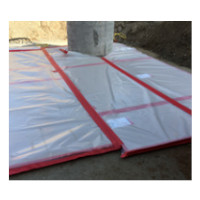 Degradable void forms, made from materials like corrugated and moulded paper, need protection from moisture when stored until the concrete is poured for building foundations.
Degradable void forms, made from materials like corrugated and moulded paper, need protection from moisture when stored until the concrete is poured for building foundations.
Collapsible former will degrade due to moisture absorption and soil bacterial attack, resulting in the formation of a void beneath the concrete.
Pictures credit: maxfrank.com, thefpa.wildapricot.org
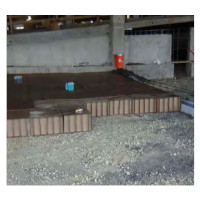
3. Non-Degradable, compressible - EPS blocks, bubble former, plastic former, pvc former
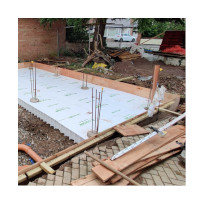 Non-Degradable Void Forms are fabricated from materials that normally do not degrade, such as plastic, polystyrene.
Non-Degradable Void Forms are fabricated from materials that normally do not degrade, such as plastic, polystyrene.
The design of foundations with non-degradable Void Forms must acknowledge that these Void Forms will remain in place for a very long time.
For example, plastic void formers can be manufactured using recycled materials, providing additional protection against ground moisture.
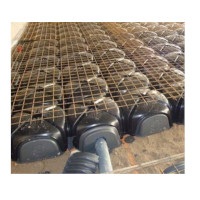
On the other hand, EPS blocks like Filcor serve as disposable elements for creating openings in concrete structures. The same company producing Filcor also offers rectangular EPS legs shaped to fit under beams and slabs, covered with Corex – a twin-fluted polypropylene material.
Next in line are bubble formers and the revolutionary BubbleDeck® technology, which is widely acknowledged as an innovative construction approach. This method removes ineffective concrete from the neutral axis of a concrete slab, resulting in a considerable decrease in the overall weight. The formation of bubble formers happens naturally, driven by the interplay of two essential components: reinforcement (metal bars) and hollow plastic balls.
Pictures credit: directpiling.co.uk,cresco-group.com
MATERIALS USED TO MAKE VOID FORMS
• Corrugated Paper
• Moulded Plastic - bubble slab, EPS blocks
• Moulded Paper - cardboard
• Styrofoam/EPS/Polystyrene
AVAILABLE VOID FORMERS IN UK / WHAT PRODUCTS CAN BE USED FOR VOID FORMING APPLICATIONS
Void former manufacturers are ready to advise on the appropriate method for placing and securing their product, and quite a few of them provide a specialised type of support to make the process easier. Additionally, many of these manufacturers provide comprehensive PDF documents for a closer look at their products, facilitating a better understanding of their specifications and applications.
There are a few void former manufacturers in the UK, and here are the main and most popular ones:
- Cordek - Cellcore® HX S pdf, Cellcore® HX B pdf, Heaveguard pdf, Cellcore® HX Plus pdf, Filcor 20 pdf, Filcor 45 pdf, Filcor 70 pdf, Filcor 90 pdf, Filcor 100 pdf, Filcor 120 pdf, Filcor 140 pdf, Filcor 160 pdf, Filcor 190 pdf
- Dufaylite - Clayboard pdf
- Whiterock - Heave stopper pdf
- Premcrete - Void-tek® pdf
- Max-frank - Pecavoid® Plus pdf, Pecavoid® RD pdf, Pecavoid® C pdf, Egcovoid® pdf
- Jablite - Fillmaster pdf
- Kore - Void Former pdf
- Bubble-deck pdf
- Stylite-pdf
MOST COMMONLY USED VOID FORMS BY ARCHITECTS
The majority of the United Kingdom is built on clayey soils, which naturally leads architects in the UK to incorporate void forms into their project designs. Among these forms, some are widely favoured, while others might be less familiar, possibly owing to specialised technology and the simplicity of installation on construction sites. Let's highlight the void forms that architects in the UK commonly choose and trust for their projects.
- Compressible EPS void formers by Cordek Company
- Filcor 20 is the most frequently chosen due to its competitive price. Unlike other fillers it can be used in water. On the other hand, Cellcore HX S grade 7/10 under slab is often selected to protect reinforced concrete slabs from the effects of clay.
- Collapsible Clayboards by Whiterock Company and Dufaylite. The product called Heave Stopper by Whiterock is a Corrugated Paper former that, after the concrete sets, is filled with water, creating a true void. Dufaylite clayboard is covered with a plastic twin-fluted Corex sheet and, similar to the Heave Stopper, is filled with water.
CONCLUSION
While certain void forms enjoy broad popularity, others may be less recognized, likely influenced by specialised technology and the ease of installation on construction sites. This underscores the importance of acknowledging the commonly used and trusted void form products preferred by architects in the UK for their construction projects.
BIBLIOGRAPHY
1.thefpa.wildapricot.org, ’SPECIFICATION AND APPLICATION OF VOID SPACES BELOW CONCRETE FOUNDATIONS’, pdf, November 12, 2014, accessed January 17, 2024.
2. thefpa.wildapricot.org, ’VOID SPACES’, pdf, January 9, 2008, accessed January 17, 2024.
3.premcrete.com, ’THE REVOLUTIONARY GROUND HEAVE SOLUTION’, accessed January 17, 2024.
Pictures credit:
link.springer.com,
thefpa.wildapricot.org,
cresco-group.com,
industrysearch.com.au,
cresco-group.com
Related articles:
COST-EFFICIENT UK ANTI-HEAVE PROTECTION: TOP 3 NEAR YOU
HOW TO CUT POLYSTYRENE VOID FORMER
Foundation heave problems. Heave Symptoms
Don't let your foundation fail
Understanding Dufaylite Honeycomb Claybord Void Former
Filcor lightweight structural fill
How to insulate under concrete floor. The ultimate guide
*Insulationgo LTD strives to keep the content accurate and up-to-date, but we cannot be held responsible for any mistakes or exclusions.
The information in this blog isn't expert advice and shouldn't replace talking to the right specialists. Before buying or deciding anything based on this info, it's best to contact the product manufacturer directly to double-check if it's right for what you need.
Descriptions, drawings, photographs, data, proportions, weights, and measured values provided here may change without prior notice and do not establish the guaranteed contractual quality of the products. The recipient of these products holds the responsibility to comply with proprietary rights, existing laws, and legislation.
Using this blog implies acknowledgment and agreement that Insulationgo LTD cannot be held accountable for any damages, losses, or inconveniences resulting from the use or reliance upon the information provided. This limitation of liability extends to all users of the blog, including visitors, readers, and subscribers.










































































































